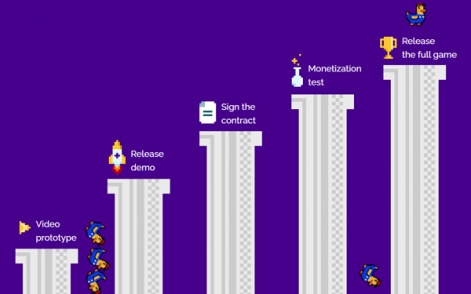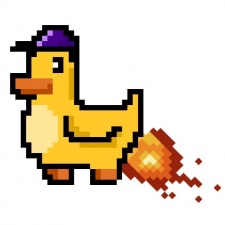Ivan Fedyanin is CEO and co-founder of Ducky, a fast-growing hypercasual publishing studio.
A hypercasual game is minimalistic with simple gameplay.
The hypercasual genre is also a race for developers to create a game that will gain millions of installs and thousands of ad revenue dollars.
For players, these games are satisfying and addictive, and for the developers, they are relatively easy to develop.
Still, even once a developer has created a hypercasual game, there are still many processes left to complete: testing, marketing, promotion and analytics.
This is where publishers come on stage. They help developers to get closer to the hit game.
With their publisher’s help, the developer makes the maximum number of attempts in a limited amount of time.
The publisher runs the game prototype through the testing funnel and estimates whether the game will be profitable before release.
How testing starts at the idea stage
Each publisher has different capabilities on how to test the product. Those who can test prototypes at the earliest stages, save developers time and resources.

Everything starts with the idea. Here is what the process looks like:
- Gameplay video test
As fast as developers have the idea for the game, they should make a simulated video of its future gameplay. It takes the developer two to three business days to make. Publishers run the ads with this video and test the validity of the idea. This stage is called the CTR test (we'll look at the meaning of this metric in the next paragraph).
- Game prototype with basic functionality test
If CTR test shows great metrics, developers get a signal to move on and develop a simplified version of a game. It includes basic mechanics, a few levels for two to three minutes of gameplay, and it takes the developer five to seven business days of development. Publishers run the ads again and test cost per install and retention. This stage is called the CPI test.
- Monetisation and scalability tests
Once CPI test results are awesome, developers take another five to 10 working days to add more gameplay on top of the previous build, as well as the first integration of monetisation functionality and gameplay features.
If the metrics are bad at any of the mentioned stages, the idea is buried and developers make the next prototype to test.Ivan Fedyanin
If the metrics are bad at any of the mentioned stages, the idea is buried and developers make the next prototype to test. On average, developers test 40 projects (and shut down 39 of them) before one of them reaches great metrics.
Which metrics do publishers aim to get
To evaluate the demand, publishers run an ad and measure a range of metrics. There are certain values that developers and publishers desire to see.
These tests are typically run on a US audience only and will vary for other countries. All metrics are interconnected and quite simple to understand:
- CTR: Click-Through Rate
It is the percentage of users who have clicked on the ad after seeing it. The target CTR is above two per cent. A level of 1.1 per cent is low on average.
Anything below two per cent is considered bad. If an ad of gameplay reaches target metrics, developers prepare a raw version of the real game.
- CPM: Cost Per Mille
It is the amount the ad network charges money for each thousand displays of the ad. This metric shows how much it costs to show an ad to potential users 1,000 times.
The target CPM is below $20. A level of $25 is low average. Anything above $35 is considered bad, except for games with a long user lifetime.
- CPC: Cost Per Click
It is the actual price you pay for each click on the ad. Cost per click is calculated by multiplying the cost per mile and click-through rate, so CPC = CPM multiplied by CTR.
The target CPC is $0.2. A level of $0.5 is a low average. Anything above $0.35 is considered bad for typical hypercasual games, except for games with long user lifetime.
- IR: Install Rate
It is the percentage of users who have installed the game after clicking the ad. The target Install Rate is 60 to 75 per cent. A level of 50 to 60 per cent is a low average. Anything below 50 per cent is considered bad.
- IPM: Install Per Mille
Install per mille is the number of times your app or game is installed per thousand ad impressions. This metric helps to evaluate how effectively the ad converts potential users to installs.
Some ad networks may perform significantly better when IPM is high. The target IPM is above 80/40 (for Android/iOS). A level of 30/15 (Android/iOS) is low average. Anything below 40/20 (Android/iOS) is considered bad.
- CPI: Cost Per Install
This metric means how much does it cost you to acquire a new user - this is what publishers and developers mainly focus on.
Cost per install is calculated by multiplying cost per click and install rate, so CPI equals CPC multiplied by IR. The target CPI for iOS is not higher than $0.4. A level below $0.3 is considered good.
What publishers do with testing figures
If the metrics are very good, publishers allow developers to go to the next stage of development. The more test stages are passed successfully, the more likely a game will be a success upon release.
Hypercasual is a race for developers to create a game that will gain millions of installs and thousands of ad revenue dollars.Ivan Fedyanin
If the metrics are just ok, the publishers are less enthusiastic. That's because at the scale phase (after all stages of successful testing) good metrics gradually decrease. This is why publishers are only looking for the very good ones.
If the metrics are bad, a game has to be dismissed because its CPI will be high in the future, and it will not be profitable. The path to a profitable game is paved by numerous rejected ideas. Each metric signals are a lot more than just numbers. Publishers and developers aim to understand what went wrong and how this could be improved the next time.
Working together
This is possible only if the developer learns from their own mistakes, pays attention to the analytics and accepts publisher's expertise where it's necessary.
For example, the developers usually don't have much experience with monetisation and don't know exactly how to build it into the game. The publishers know how to add monetisation and get the maximum income from the user without decreasing his lifetime. They share this expertise.
Many people are involved in game publishing, such as traffic buying, optimisation, monetisation, localisation, testing and support specialists.
They have learned to predict that games will be profitable even before they are fully launched. This allows the developer to save resources and come up with a very profitable game, cutting out all the underperforming options along the way.
Ivan Fedyanin is CEO and co-founder of Ducky, a fast-growing hypercasual publishing studio.
Ivan has spent 19 years in mobile gaming, and together with the co-founder of Ducky Alisher Yakubov, has managed the development and publishing of 30 games, including such top games as American Dad Apocalypse Soon, Bombastic Brothers and Planet of Heroes.






















